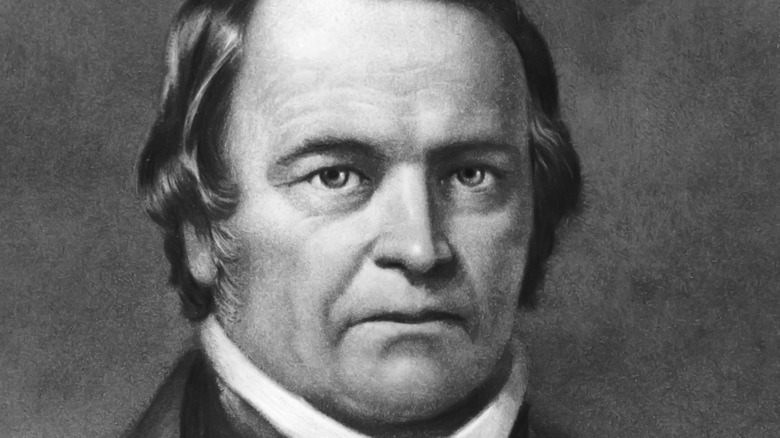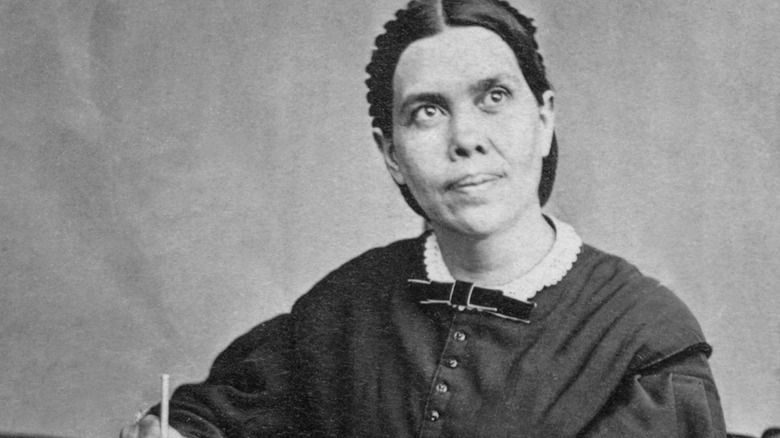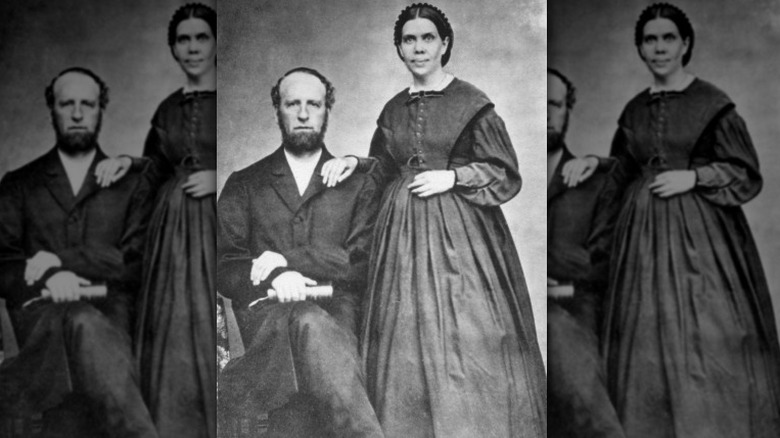The Untold Truth Of Seventh-Day Adventists
If you live on the West Coast or in the South, you may have encountered a religious group known as Seventh-day Adventists (SDAs). They've made news because of their unusually long life expectancy in comparison to the rest of the U.S. population. And there's also the fact that Ben Carson, a celebrated pediatric neurosurgeon and Adventist, ran for president in 2016 as a Republican (via Ballotpedia). He ended his campaign that March, but went on to serve as the 17th Secretary of Housing and Urban Development in the Trump administration, per ABC News.
For some Americans, Carson's candidacy marked the first time they'd heard much about the Seventh-day Adventist Church. Others were familiar with the stance many Christian denominations had taken over the years, arguing that Adventism was a cult. But since the 1950s, this stance has softened, as reported by the Gospel Coalition. The reason for the shift has to do with an active dialogue between SDA church officials and leaders of other Christian denominations since the mid-20th century.
But the Gospel Coalition hedges its bets, noting, "Although few evangelicals today consider SDA a non-Christian cult, many still caution against embracing the denomination as an acceptable branch of Protestantism." Although controversy and hesitation still swirl around the SDA faith in some people's minds, the church continues to grow worldwide. In fact, it's one of the most ethnically and racially diverse faiths on the planet. Keep reading for more fascinating untold truths about Seventh-day Adventism.
Church numbers have remained remarkably stable
Seventh-day Adventists comprise one-half of 1% of the American population, according to the Pew Research Center. That's a slight increase over 2007 at 0.4%, which represents a remarkable continuity of numbers compared to other Christian denominations.
Overall, the share of the U.S. population who identify as Christian has dropped 8% over the same period. Whether we're talking Evangelicals, Methodists, or Lutherans, most denominations have seen a decline among members (per the Pew Research Center), making the SDA's small growth noteworthy. This retention is fascinating, because the Seventh-day Adventist Church has had a lot to overcome since its official establishment in 1863. Back then, some people saw it as a cult, especially individuals within more mainstream Christian faiths.
Nevertheless, the Seventh-day Adventist faith has overcome criticism from mainstream organizations, sometimes changing minds about its alleged cult status. The SDA church has also proven it offers a belief pathway that some people continue to flock toward despite rigorous requirements like keeping the Sabbath and adhering to healthful eating and even vegetarianism.
They're a diverse group
Pew Research Center reports Seventh-day Adventists are among the most ethnically and racially diverse religious groups in the United States. Polls reveal that church members identify as 37% white and 32% Black. The group also boasts a membership that is 15% Hispanic, 8% Asian, and 8% mixed race. As a result of this incredible diversity, it's not uncommon to walk into an Adventist congregation in the U.S. and find that English is not the first language of the church, according to the Adventist News Network (ANN).
Gary Krause, an SDA spokesperson, explains, "We're not an American church. We're not an African or Asian church. We're not a European church. We're a worldwide movement with a mission to all people groups." But how does this diversity compare to other faiths? The Pew Research Center gave the SDA Church a 9.1 on a diversity index, while the U.S. adult population overall scores a 6.6. Regarding the next most diverse faith after SDAs, Muslims came in second with a rating of 8.7. At the other end of the spectrum, the traditionally Black National Baptist Convention received a 0.2.
As for where church members tend to live, the majority inhabit the Southern and Western United States. The South is home to approximately 40% of all Adventists in the U.S., while 31% live in the West. About 10% of America's SDA adherents live in the Midwest.
Seventh-day Adventists express exceptional devotion
Compared to your average American, SDAs express an extraordinary level of devotion, per the Pew Research Center. For example, nine out of 10 profess complete certainty in the existence of God. Two-thirds attend church weekly — a larger share than other Protestant denominations — and 86% report praying daily. Compare this to just 55% of American adults who do the same, and that's a significant behavioral difference for those in the church.
Additionally, 83% of Seventh-day Adventists rank religion as very important to their daily lives, as opposed to 53% of adult Americans. Regarding how faith impacts their daily lives, SDA believers keep the seventh-day Sabbath, which is observed every Saturday. Keeping the Sabbath as a day of rest is outlined in the fourth of the Ten Commandments (as reported by the Reporter-Times). This sets the denomination apart from other Christian churches, aligning it with the same holy day as the Jewish faith.
Besides keeping the seventh-day Sabbath, SDA followers also observe healthful practices like eating a primarily vegetarian diet. They abstain from drugs, alcohol, and smoking. Adventists categorize these substances as "unclean chemicals" (via the Addiction Center). According to the Adventist Guide, SDA churches also advise against consuming soft drinks, tea, coffee, and CBD. Those who don't eat an entirely vegetarian diet still avoid "unclean meats" like pork — dietary restrictions that are similar to ones followed by observant Jews and Muslims. Restrictions like this make the SDA denomination far more rigorous than many Christian faiths.
They are politically and ideologically diverse, too
When Ben Carson ran for president in 2016, the North American Division of the Seventh-day Adventist Church released a statement about the church's political neutrality, per the Adventist Review. It noted, "The Adventist Church has a longstanding position of not supporting or opposing any candidate for elected office." The church explained this position by pointing to its historical stance on the separation between church and state and its tax-exempt status.
The church also used the statement to remind its members not to use political positions to enhance its status or to take away from the faithful of other denominations. The statement re-asserted the SDA faith's stated goal of strengthening religious freedom for everyone and its belief that church members should take up their civic responsibilities and vote in all elections. About 35% of church members are Republicans, while 45% identify as Democrats, according to the Pew Research Center. Another 19% are independents or don't hold allegiances to either party.
Church followers are spread across the ideological spectrum on other issues. Only 19% of SDAs, like Carson, vehemently oppose abortion, while 54% say it should be legal. As for LGBTQ+ issues and marriage equality, the church is more united in its opposition. Approximately 59% of SDAs believe homosexuality should be discouraged, and 63% don't support same-sex marriage.
Seventh-day Adventists reject evolution
Ben Carson remains a strong critic of evolution, arguing that it's impossible to believe in God and evolution, as reported by Buzzfeed News. In an interview with the Adventist Review, Carson stated, "Ultimately, if you accept the evolutionary theory, you dismiss ethics, you don't have to abide by a set of moral codes, you determine your own conscience based on your own desires."
In this stance, he mirrors the two-thirds of Seventh-day Adventists who believe that "humans have always existed in their present form" (via the Pew Research Center). Carson notes that he went through school and received the same education as other children, especially when it came to an understanding of evolution. But after careful consideration and reflection, he concluded that, to him, evolution and a belief in God don't mesh. As a result, he chose religion over science and encourages others to do the same.
Carson's stance is shared by most SDA believers. This is another area where they diverge from other Christian denominations. Interestingly, the SDA belief in creationism stems from the Fourth Commandment, in which God set aside the Sabbath as holy, per Beyond Today. Adventists believe the Sabbath should be observed as a testament to God's act of creation. Considering the titular importance of the seventh day in the group's belief system, it also stands to reason they'd reject other things that deviate from the Fourth Commandment.
Seventh-day Adventism traces its roots to the Second Great Awakening
The Second Great Awakening took place in the United States in the late 1700s and early 1800s, per Britannica. During this time, more people than ever before had access to Bibles and started studying the Scriptures, according to the SDA World Church. As a result, many people became convinced of concepts such as the Second Coming of Christ and the seventh-day Sabbath.
The founders of Adventism decided these concepts were so central to Christianity that they must be incorporated into their daily beliefs and actions, even if this meant forming something new. Such ideas spread like wildfire in revival tents across the United States as people searched for a deeper connection with the divine.
Although disparate groups of people interested in these religious concepts remained scattered across Northeastern America, they eventually banded together, forming the Advent Movement. They included everyone from Presbyterians to Methodists, Baptists, and Congregationalists (via Learn Religions). The term "advent" came from their firm belief that Jesus' Second Coming was right around the corner (via the SDA World Church). But this conviction about the imminent end of the world also led to trouble for the first Adventists, who found themselves embroiled in an existential crisis from the get-go.
Seventh-day Adventism came out of the Millerite Movement
Seventh-day Adventism got off to a rough start in the 1830s and '40s when a man named William Miller decided Christ's Second Coming was at hand, per Learn Religions. He based this belief on a prophecy found in the Book of Daniel and estimated the end of the world would occur between 1843 and 1844. When Miller's date proved off, it led to "The Great Disappointment."
After the Millerite Movement failed, Miller stepped down from his leadership position, and he died in 1849. As for his former believers, some left the church altogether. Others returned to other pathways of Christianity. But a select few kept studying, discovering what they saw as a series of long-forgotten and neglected beliefs. These included concepts such as the seventh-day Sabbath and the idea that the dead are essentially sleeping, awaiting either the return of Christ or a final judgment. These concepts paved the way for what would become known as Seventh-day Adventism, as reported by the SDA World Church.
These Christians realized that although Miller had been wrong about the date he estimated for the Second Coming, the passages from the Book of Daniel and the Book of Revelation remained crucial to biblical prophecy. They also saw them as vital to understanding God's plan, even as they acknowledged it would be foolhardy to put a date to any of these events. Nevertheless, they persisted in believing that the Second Coming lay right around the corner, a literal event to be witnessed by the entire world.
A young woman put the church back on track
During this tumultuous time, an unlikely prophetess stepped to the forefront to guide the emerging church, according to Learn Religions. Her name was Ellen Gould Harmon White, and her influence proved essential to the Seventh-day Adventist Church, as reported by Britannica.
White began as one of the many Millerites who would endure "The Great Disappointment." But in December 1844, everything changed when she received the first of what she claimed were approximately 2,000 religious dreams and visions. Two years later, she married an Adventist minister, the Reverend James S. White, and they traveled New England preaching Seventh-day Adventism. Inspired by the supernatural visions she claimed to see, she wrote and published many books, including "A Sketch of the Christian Experience and Views of Ellen G. White" and "Supplement to the Experience and Views of Ellen G. White." Both books came out in the early 1850s.
The books contained her alleged prophetic insights and the biblical interpretations stemming from them. These views were heartily accepted with little challenge in an Adventist movement searching for meaning and perspective. With the publication of "Testimonies for the Church" in 1855, she laid out daily practices for church members. The nine-volume work covered many aspects of Adventist belief and practice, including her thoughts about health and prohibitions against unclean and unhealthful substances like coffee and meat.
Ellen G. White may have been a Black woman
According to The Washington Post, Ellen G. White sometimes made contradictory statements about racial equality. But she also wrote some brilliant, progressive passages decrying discrimination in the church. SDAs were abolitionists even before the Civil War, per Britannica. Blacksdahistory notes that White wrote extensively about the Civil War and its aftermath. She confronted issues like racial segregation and Jim Crow laws, stressing the Adventist role in improving the lives of those impacted by these social evils. She maintained close ties with Black communities in the U.S.
Some evidence suggests White might have been a Black woman. Charles Edward Dudley formally made this claim in his book "The Genealogy of Ellen G. White" (via EGW Writings). Dudley claims that White's mother, Eunice Gould Harmon, traced her roots to New Jersey and the Caribbean. He argues that the plight of African Americans remained close to White's heart because she was part of their community.
He also points out that White and her husband gravitated to Black communities in their travels, conveniently avoiding miscegenation laws, which would have invalidated their union. He argues, "In Battle Creek, memorials are being erected in honor of two great women, Harriet Tubman and Sojourner Truth. It would be proper to have another erected in honor of another great African-American woman, Ellen Gould Harmon White." White's racial identity persists as a topic of inquiry for many SDA researchers, per Spectrum Magazine.
Seventh-day Adventists correlate physical and spiritual health
In 1863, Ellen G. White claimed she had a vision about the relationship between physical and spiritual health, as reported by Ronald L. Lawson. In their odyssey for better health, the Whites eventually relocated to Battle Creek, Michigan, home to the Battle Creek Sanitarium founded by John Harvey Kellogg. Kellogg invented corn flakes, peanut butter, and the concept of health vacations.
He established a thriving business attracting the affluent to his sanitarium for massages, water treatments, and education about the benefits of a vegetarian diet. The Adventist staff used such retreats to bring spiritual awareness to visitors, obeying White's suggestion that medical work represented "the entering wedge" or "the right arm of the message." Soon, sanitariums crisscrossed the country, serving the wealthy in search of long life and elusive health cures.
These facilities acted as entries into the missionary field for medically trained Adventists. By 1901, as many as 75 mission hospitals and sanitariums existed. With so much focus on health and wellbeing, it's little wonder Adventist hospitals still rank highly in the United States (via Adventist Health). Adventist hospitals are among the top-rated treatment facilities for COPD, heart failure, neurosurgery, and orthopedics.
Seventh-day Adventists have longer-than-average life expectancies
Because of their emphasis on healthful eating and living and their abstinence from drugs, alcohol, and smoking, Seventh-day Adventists are among the longest-living people in the world, as reported by Next Avenue. The company researched "Blue Zones" across the globe — places where longevity is impressive and verifiable. Loma Linda, California, sits near the top of the list.
Next Avenue explains that Loma Linda earned that distinction because approximately one-third of its 24,196 residents are Seventh-day Adventists who embrace a healthy lifestyle. Because they believe their bodies are God's temples, they refrain from practices prohibited by Ellen G. White, including smoking, drinking, and eating meat. They also make exercise a regular part of their lifestyle.
This religious devotion and adherence to rigorous dietary rules pay big dividends later in life. Scientific studies have demonstrated that Seventh-day Adventists live up to a decade longer than your average Joe or Jane, per the Los Angeles Times. As a result, the faith boasts an abnormally high number of centenarians who remain active and clear of mind. In Loma Linda, it's not uncommon for people to feel energetic well into their 90s and even past 100. Apparently, the health ministry founded by White is still working, attracting new members and helping believers live longer and better.











